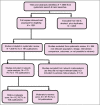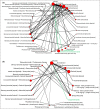A systematic review and network meta-analysis of topical pharmacological, oral pharmacological, physical and combined treatments for acne vulgaris
- PMID: 35789996
- PMCID: PMC9804728
- DOI: 10.1111/bjd.21739
A systematic review and network meta-analysis of topical pharmacological, oral pharmacological, physical and combined treatments for acne vulgaris
Abstract
Background: Various treatments for acne vulgaris exist, but little is known about their comparative effectiveness in relation to acne severity.
Objectives: To identify best treatments for mild-to-moderate and moderate-to-severe acne, as determined by clinician-assessed morphological features.
Methods: We undertook a systematic review and network meta-analysis of randomized controlled trials (RCTs) assessing topical pharmacological, oral pharmacological, physical and combined treatments for mild-to-moderate and moderate-to-severe acne, published up to May 2020. Outcomes included percentage change in total lesion count from baseline, treatment discontinuation for any reason, and discontinuation owing to side-effects. Risk of bias was assessed using the Cochrane risk-of-bias tool and bias adjustment models. Effects for treatments with ≥ 50 observations each compared with placebo are reported below.
Results: We included 179 RCTs with approximately 35 000 observations across 49 treatment classes. For mild-to-moderate acne, the most effective options for each treatment type were as follows: topical pharmacological - combined retinoid with benzoyl peroxide (BPO) [mean difference 26·16%, 95% credible interval (CrI) 16·75-35·36%]; physical - chemical peels, e.g. salicylic or mandelic acid (39·70%, 95% CrI 12·54-66·78%) and photochemical therapy (combined blue/red light) (35·36%, 95% CrI 17·75-53·08%). Oral pharmacological treatments (e.g. antibiotics, hormonal contraceptives) did not appear to be effective after bias adjustment. BPO and topical retinoids were less well tolerated than placebo. For moderate-to-severe acne, the most effective options for each treatment type were as follows: topical pharmacological - combined retinoid with lincosamide (clindamycin) (44·43%, 95% CrI 29·20-60·02%); oral pharmacological - isotretinoin of total cumulative dose ≥ 120 mg kg-1 per single course (58·09%, 95% CrI 36·99-79·29%); physical - photodynamic therapy (light therapy enhanced by a photosensitizing chemical) (40·45%, 95% CrI 26·17-54·11%); combined - BPO with topical retinoid and oral tetracycline (43·53%, 95% CrI 29·49-57·70%). Topical retinoids and oral tetracyclines were less well tolerated than placebo. The quality of included RCTs was moderate to very low, with evidence of inconsistency between direct and indirect evidence. Uncertainty in findings was high, in particular for chemical peels, photochemical therapy and photodynamic therapy. However, conclusions were robust to potential bias in the evidence.
Conclusions: Topical pharmacological treatment combinations, chemical peels and photochemical therapy were most effective for mild-to-moderate acne. Topical pharmacological treatment combinations, oral antibiotics combined with topical pharmacological treatments, oral isotretinoin and photodynamic therapy were most effective for moderate-to-severe acne. Further research is warranted for chemical peels, photochemical therapy and photodynamic therapy for which evidence was more limited. What is already known about this topic? Acne vulgaris is the eighth most common disease globally. Several topical, oral, physical and combined treatments for acne vulgaris exist. Network meta-analysis (NMA) synthesizes direct and indirect evidence and allows simultaneous inference for all treatments forming an evidence network. Previous NMAs have assessed a limited range of treatments for acne vulgaris and have not evaluated effectiveness of treatments for moderate-to-severe acne. What does this study add? For mild-to-moderate acne, topical treatment combinations, chemical peels, and photochemical therapy (combined blue/red light; blue light) are most effective. For moderate-to-severe acne, topical treatment combinations, oral antibiotics combined with topical treatments, oral isotretinoin and photodynamic therapy (light therapy enhanced by a photosensitizing chemical) are most effective. Based on these findings, along with further clinical and cost-effectiveness considerations, National Institute for Health and Care Excellence (NICE) guidance recommends, as first-line treatments, fixed topical treatment combinations for mild-to-moderate acne and fixed topical treatment combinations, or oral tetracyclines combined with topical treatments, for moderate-to-severe acne.
© 2022 The Authors. British Journal of Dermatology published by John Wiley & Sons Ltd on behalf of British Association of Dermatologists.
Conflict of interest statement
I.M., L.B., S.D., N.B., S.A., L.F. and K.D. received support from the NGA for the submitted work. C.H.D., N.J.W. and D.M.P. received support from the National Institute for Health and Care Excellence (NICE) Guidelines Technical Support Unit for the submitted work. J.W., J.H.R., D.W., M.R. and E.H. declared the following interests based on the NICE policy on conflicts of interests (
Figures


Comment in
-
Stratification according to disease severity can better reveal the relative effectiveness of treatments for acne vulgaris.Br J Dermatol. 2022 Nov;187(5):637-638. doi: 10.1111/bjd.21849. Epub 2022 Sep 5. Br J Dermatol. 2022. PMID: 36065489 No abstract available.
References
-
- Tan JK, Bhate K. A global perspective on the epidemiology of acne. Br J Dermatol 2015; 172 (Suppl. 1):3–12. - PubMed
-
- Tan JK. Psychosocial impact of acne vulgaris: evaluating the evidence. Skin Therapy Lett 2004; 9:1–3, 9. - PubMed
-
- Layton AM, Thiboutot D, Tan J. Reviewing the global burden of acne: how could we improve care to reduce the burden? Br J Dermatol 2021; 184:219–25. - PubMed
-
- Moradi Tuchayi S, Makrantonaki E, Ganceviciene R et al. Acne vulgaris. Nat Rev Dis Primers 2015; 1:15029. - PubMed

